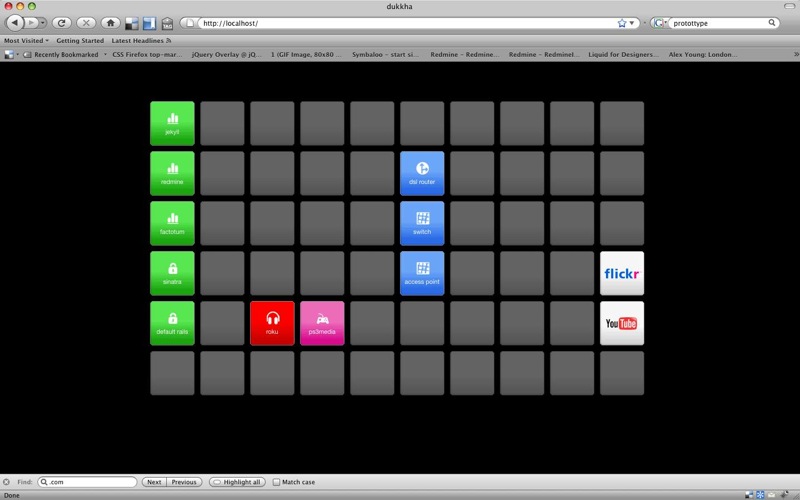I realized over the weekend that I needed some form of ‘startpage’. I have a bunch of access-points, switches, servers and applications, each with its own access url, and I wanted a simple, configurable page, with a link to each server/app, that I could set my homepage to. I quick google led me to this site: symbaloo. I loved the cool grid-layout but wasn’t interested in relying upon an external site, so I decided to spend Sunday afternoon knocking something similar up.
Besides, I have been dying to play with the awesome Sinatra, which looked perfect. Coupled with hpricot for XML parsing, and jQuery for all-round awesomeness, we have everything we need to build something like this in a couple hours.
Configuration
Lets start by defining the configurable variables of a ‘cell’ (one of the table elements), it looks a little like this:
<cell> <coords><x>5</x><y>1</y></coords> <image>router.gif</image> <text>dsl router</text> <color>#ffffff</color> <background>blue.gif</background> <url>http://192.168.1.1</url> </cell>
Which should give us everything we need.
Hpricot
Life couldn’t be any easier when we’re parsing XML in ruby, so I took the liberty of firstly creating a Cell class to hold what we need:
class Cell
@@attrs = [:x, :y, :image, :text, :color, :background, :url, :tooltip]
@@attrs.each {|a| attr_accessor a }
def initialize(cell)
@@attrs.each do |a|
self.send("#{a}=", (cell/a).inner_html)
end
[:x, :y].each {|a| self.send("#{a}=", self.send(a).to_i)}
end
end
Along with a quick XML parsing routine:
def load_config(xml_config)
config = File.read(xml_config)
doc = Hpricot.parse(config)
# cells = multi-d array using width & height
width = (doc/:cells/:width).inner_html.to_i
height = (doc/:cells/:height).inner_html.to_i
cells = Array.new(height)
height.times { |h| cells[h] = Array.new(width) }
(doc/:cells/:cell).each do |cell_html|
cell = Cell.new(cell_html)
cells[cell.y][cell.x] = cell
end
cells
end
And we have our table config’d and loaded.
Sinatra
Next up, is the fantastic Sinatra. By no stretch of the imagination did I make use of its best features here, in fact all I’m really doing is using it as a glorified web-server, but the project did give me an opportunity to play around with some of its cooler features and I have a project in mind already for next weekend.
All we’re really going to do here is load the XML into our multi-dimensional array and delegate the display to the view (as it should be):
get '/' do @cells = load_config erb :index end
Finally, all of the Javascript resides in the view, which I won’t replicate here, but lets just say that jQuery makes life easier than it should be and I’d recommend it to anybody. I used Prototype pretty extensively for a while (because it shipped with Rails), but over the last year or so, jQuery has become my Javascript framework of choice.
The Result
And thats about it, 1 XML file, 1 Ruby file and 1 View and 1 CSS file later, we end up with something that looks like this:
You will notice I’ve replicated the symbaloo layout and used some of their icons. Credit where credit’s due, their site looks great and I encourage you to head over there and check it out.
A name, and Internet Explorer
Which leaves us with a name to choose. I settled upon Dukkha because I am reading about Buddhism and was extremely impressed to find it defined the fundamental disquiet we experience as beings, trapped between the assumption of an eternal self (atman) and the denial of such a self (anatman).
Speaking of “having a poor axle hole,”, thats pretty much how I felt when I discovered Internet Explorer didn’t want to play nicely with my XHTML and CSS. If Microsoft browsers are your thing, I graciously invite you to fork off in github and make it look pretty.
The project is available on github to fork and/or download.
